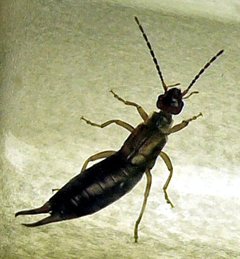Earwig
|
|
| Earwigs | ||||||||
|---|---|---|---|---|---|---|---|---|
 Female (no hooked cerci) | ||||||||
| Scientific classification | ||||||||
| ||||||||
| Families | ||||||||
|
Suborder Archidermaptera
Suborder Forficulina
Suborder Hemimerina Suborder Arixenina |
The earwigs are an order (Dermaptera) of insects characterized by large membraneous wings folded underneath short leathery forewings (thus the literal name of the order - "skin wings"). The abdomen extends well beyond the wings, and frequently, though not always, ends in a pair of forceps-like cerci. With about 1,800 recorded species in 10 families, the order is relatively small among the Insecta, but the earwigs themselves are quite common throughout the world, often finding their way into houses, where they are usually first noticed scurrying across the floor.
Most earwigs are elongated and low to the ground, and are dark brown in color. Lengths are mostly in the 10-14 mm range, with a species of St Helena reaching 80 mm. The cerci range from nonexistent, to long arcs up to 1/3 as long as the rest of the body. Mouthparts are adapted for chewing. The hindwings are folded in a complicated fashion so that they fit under the forewings; but despite all the trouble, earwigs rarely fly.
The earwig abdomen is flexible and muscular, and capable of both maneuvering and opening/closing the forceps. The forceps seem to be used for a variety of purposes. Their role in self-defense is familiar to every child whose first grab at a passing earwig resulted in a pinch—more surprising than painful, the forceps not being particularly strong. In some species, the forceps have also been observed in use for holding prey, to unfold the wings, and in copulation. There is also conclusive proof that earwig males grow a spare set of genitals in the event of his first set being snapped off or otherwise damaged.
The name "earwig" is said to originate from an old belief that earwigs crawl into people's ears and lay eggs in the brain. Earwigs do tend to prefer being in hidden places, and on very rare occasions have been known to find their way into a human ear canal, but only as far as the eardrum and certainly never into the brain. Another explanation is that it is an alteration of "ear-wing", after the shape of the hind wings when unfolded; but it's important to note that the Oxford English Dictionary states unequivocally that the name is derived from Old English words for ear and wiggle "from the notion that it penetrates into the head through the ear."
Fossil Earwigs are known from the Jurassic on, about 70 specimens having been found as of 2003.
Species:
- Common earwig Forficula auricularia
References
Taylor, J. D. 1978. The earwig: The truth about the myth. Rocky Mountain Medical Journal 75:37-38.
Forficula_auricularia.jpg
External links
- Tree of Life info for Dermaptera (http://tolweb.org/tree?group=Dermaptera&contgroup=Neoptera)
- CSIRO Dermaptera page (http://www.ento.csiro.au/education/insects/dermaptera.html)
- "Earwigs eat through your brain" urban legend debunked (http://www.snopes.com/horrors/insects/bugear.htm)da:Ørentvist
